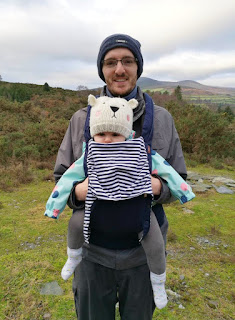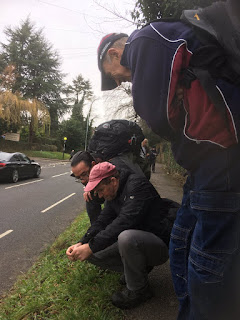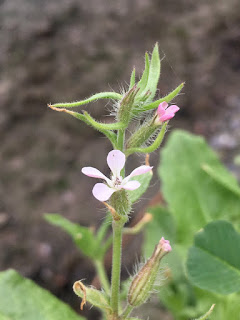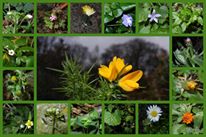 Day Three of BSBI's New Year Plant Hunt and the records keep coming in, with plant-lovers of all ages and skill levels taking part.
Day Three of BSBI's New Year Plant Hunt and the records keep coming in, with plant-lovers of all ages and skill levels taking part. Yesterday we shared a photo of young Alistair helping Daddy find plants in Epping Forest and today we have seen Joshua's children enjoying a little plant-hunting from the comfort of their push-chairs, while Roisin doesn't let the fact that she is still in a baby-sling (see image on right) stop her from helping Daddy Ciaran with those tricky plant IDs.
They both managed to find dame's-violet in bloom in Bunclody, Co. Wexford today (see image below).
As well as plant records, we've seen a couple of other records today - unless you can top them?
 We also had some records sent in from Thurso, just about the most northerly point on the UK mainland.
We also had some records sent in from Thurso, just about the most northerly point on the UK mainland. Mind you we haven't had any records in yet from Orkney or Shetland!
First we have a contender for the highest plant seen during the Hunt.
Take a look at the ivy-leaved toadflax which Martine Brennan spotted on the walls of Aghaboe Abbey, Co. Laois.
Can you find a higher plant in bloom?
 We have however seen a few records today of invasive plants.
We have however seen a few records today of invasive plants. Sarah Sells, a student on the MSc Biodiversity and Taxonomy of Plants course at RBG Edinburgh, spotted pirri-pirri burr in Berwick-upon-Tweed.
In Castletownbere, in the south-west corner of Ireland, County Recorder Clare Heardman found the invasive three-cornered leek in bloom (image on the right); and there have been multiple records across Britain and Ireland of green alkanet, which can also be a bit of a thug.
 Fortunately we haven't received any records of the EU's six 'species of Union concern' in bloom - some of them tend to spread vegetatively - but if you spot any invasive species it's worth checking if your County Recorder knows about them.
Fortunately we haven't received any records of the EU's six 'species of Union concern' in bloom - some of them tend to spread vegetatively - but if you spot any invasive species it's worth checking if your County Recorder knows about them. Lots of people have said how much they enjoy taking part in the New Year Plant Hunt, especially if they are visiting friends and family in other parts of the country and take a few hours out to go plant-hunting.
BSBI Head of Science Kevin Walker and his family went plant hunting at Fen Drayton. They only managed to see 19 species in bloom, including charlock (on left) but they did see pochard, scarce in Yorkshire where Kevin is based.
 Geoffrey Hall, County Recorder for Leicestershire & Rutland, was in south London and joined a Hunt led by Roy Vickery to Brockwell Park. They saw hoary mustard Hirschfeldia incana (image on right), a species which Geoffrey doesn't tend to see on his home patch.
Geoffrey Hall, County Recorder for Leicestershire & Rutland, was in south London and joined a Hunt led by Roy Vickery to Brockwell Park. They saw hoary mustard Hirschfeldia incana (image on right), a species which Geoffrey doesn't tend to see on his home patch. Check out this BSBI distribution map to find out where this plant has been recorded. It seems to like big cities, especially London and Manchester, and south Wales.
Remember a few years ago when Gus Routledge got the Plant Hunt bug and did five Hunts in four days in the Edinburgh area? And James Faulconbridge who plant-hunted in five locations from Devon to Lincolnshire over the course of four days in 2016?
This year it's Richard Mabbutt who has got the bug really badly! He was hunting in Leicester on Saturday, on Sunday he was in Northants with Brian Laney and his team (see photo on left, taken by Jo Gamble), today he was in Lincolnshire with Sarah Lambert's team and - unless he conks out! - tomorrow he'll be out hunting in Nottinghamshire with Jerry Clough.
That's dedication for you!
Many plant hunters apologise for not seeing many species in bloom but as we've said before, it's just as important to know what isn't flowering than what is flowering.
I was all set to sympathise with Steve Trotter, CEO of Cumbria Wildlife Trust, who only found one plant in bloom, until I saw where he was - on Lindisfarne, with St. Cuthbert's Island in the distance. I think the fabulous view (see image below right) more than compensates for the paucity of plants in bloom!
So tomorrow is the fourth and final day of the 2018-9 Hunt and there are quite a few group hunts happening.
We'll look forward to seeing what you all find and which species you can add to the current tally of 430 species spotted in bloom.
Meanwhile we'd like to wish you all a very Happy New Year and thank you for all you've done to support British and Irish botany during 2018.






















